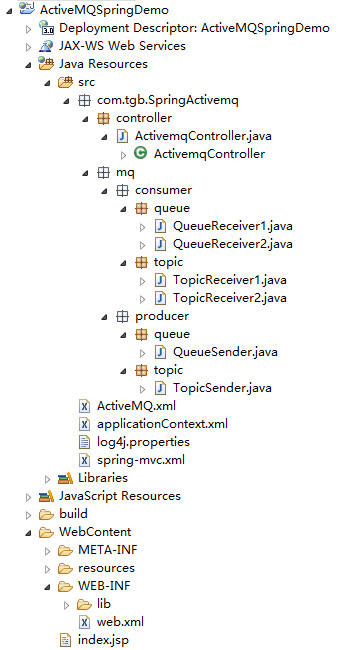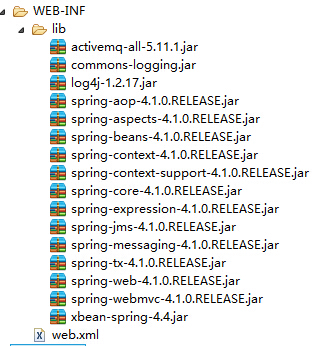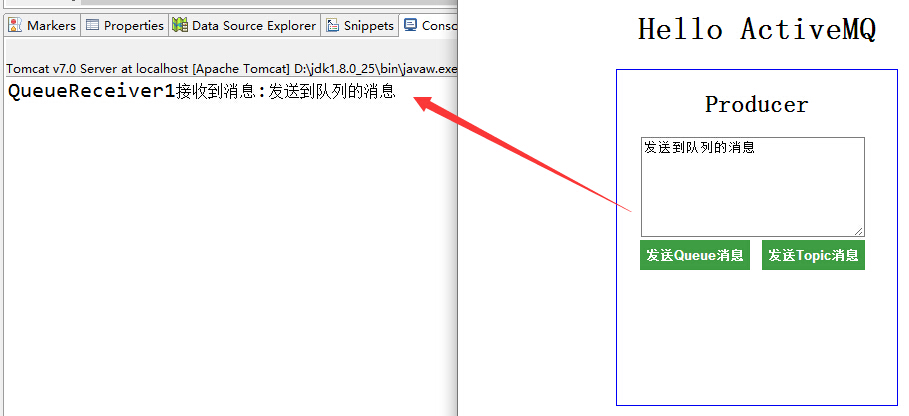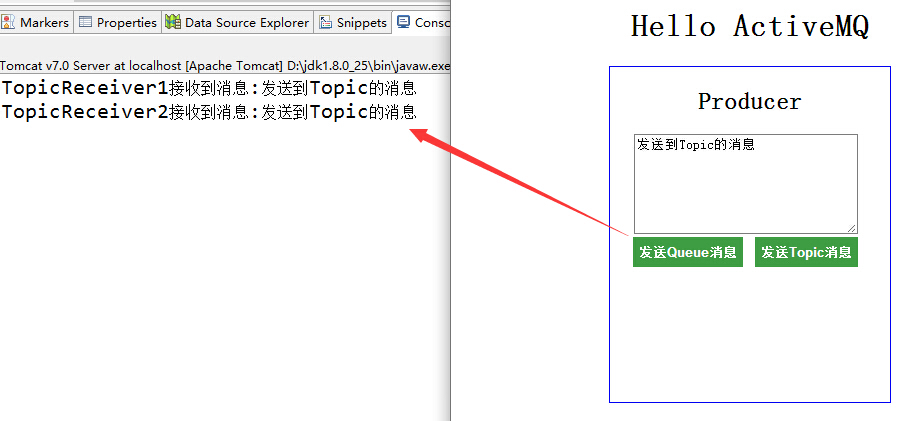第一篇博文深入浅出ActiveMQ(一)–JMS基本概念,我们介绍了JMS的两种消息模型:点对点和发布订阅模型,以及消息被消费的两个方式:同步和异步,JMS编程模型的对象,最后说了JMS的优点。
第二篇博文深入浅出ActiveMQ(二)–ActiveMQ简单介绍以及安装,我们介绍了消息中间件ActiveMQ,安装,启动,以及优缺点。
第三篇博文深入浅出ActiveMQ(三)–ActiveMQ简单的HelloWorld实例,我们实现了一种点对点的同步消息模型,并没有给大家呈现发布订阅模型。
前言
这篇博文,我们基于Spring+JMS+ActiveMQ+Tomcat,做一个Spring4.1.0和ActiveMQ5.11.1整合实例,实现了Point-To-Point的异步队列消息和PUB/SUB(发布/订阅)模型,简单实例,不包含任何业务。
环境准备
工具
-
JDK1.6或1.7
-
Spring4.1.0
-
ActiveMQ5.11.1
-
Tomcat7.x
目录结构
所需jar包
项目的配置
配置ConnectionFactory
connectionFactory是Spring用于创建到JMS服务器链接的,Spring提供了多种connectionFactory,我们介绍两个SingleConnectionFactory和CachingConnectionFactory。
SingleConnectionFactory:对于建立JMS服务器链接的请求会一直返回同一个链接,并且会忽略Connection的close方法调用。
CachingConnectionFactory:继承了SingleConnectionFactory,所以它拥有SingleConnectionFactory的所有功能,同时它还新增了缓存功能,它可以缓存Session、MessageProducer和MessageConsumer。我们使用CachingConnectionFactory来作为示例。
- 1
- 2
Spring提供的ConnectionFactory只是Spring用于管理ConnectionFactory的,真正产生到JMS服务器链接的ConnectionFactory还得是由JMS服务厂商提供,并且需要把它注入到Spring提供的ConnectionFactory中。我们这里使用的是ActiveMQ实现的JMS,所以在我们这里真正的可以产生Connection的就应该是由ActiveMQ提供的ConnectionFactory。所以定义一个ConnectionFactory的完整代码应该如下所示:
- 1
- 2
- 3
- 4
- 5
- 6
- 7
- 8
- 9
- 10
- 11
- 12
- 13
- 14
- 15
- 16
配置生产者
配置好ConnectionFactory之后我们就需要配置生产者。生产者负责产生消息并发送到JMS服务器。但是我们要怎么进行消息发送呢?通常是利用Spring为我们提供的JmsTemplate类来实现的,所以配置生产者其实最核心的就是配置消息发送的JmsTemplate。对于消息发送者而言,它在发送消息的时候要知道自己该往哪里发,为此,我们在定义JmsTemplate的时候需要注入一个Spring提供的ConnectionFactory对象。
在利用JmsTemplate进行消息发送的时候,我们需要知道发送哪种消息类型:一个是点对点的ActiveMQQueue,另一个就是支持订阅/发布模式的ActiveMQTopic。如下所示:
- 1
- 2
- 3
- 4
- 5
- 6
- 7
- 8
- 9
- 10
- 11
- 12
- 13
- 14
- 15
- 16
- 17
- 18
- 19
生产者如何指定目的地和发送消息?大家看源码即可,就不再这提供了。
配置消费者
生产者往指定目的地Destination发送消息后,接下来就是消费者对指定目的地的消息进行消费了。那么消费者是如何知道有生产者发送消息到指定目的地Destination了呢?每个消费者对应每个目的地都需要有对应的MessageListenerContainer。对于消息监听容器而言,除了要知道监听哪个目的地之外,还需要知道到哪里去监听,也就是说它还需要知道去监听哪个JMS服务器,通过配置MessageListenerContainer的时候往里面注入一个ConnectionFactory来实现的。所以我们在配置一个MessageListenerContainer的时候有三个属性必须指定:一个是表示从哪里监听的ConnectionFactory;一个是表示监听什么的Destination;一个是接收到消息以后进行消息处理的MessageListener。
- 1
- 2
- 3
- 4
- 5
- 6
- 7
- 8
- 9
- 10
- 11
- 12
- 13
- 14
- 15
ActiveMQ.xml
此时,Spring和JMS,ActiveMQ整合的ActiveMQ.xml已经完成,下面展示所有的xml
- 1
- 2
- 3
- 4
- 5
- 6
- 7
- 8
- 9
- 10
- 11
- 12
- 13
- 14
- 15
- 16
- 17
- 18
- 19
- 20
- 21
- 22
- 23
- 24
- 25
- 26
- 27
- 28
- 29
- 30
- 31
- 32
- 33
- 34
- 35
- 36
- 37
- 38
- 39
- 40
- 41
- 42
- 43
- 44
- 45
- 46
- 47
- 48
- 49
- 50
- 51
- 52
- 53
- 54
- 55
- 56
- 57
- 58
- 59
- 60
- 61
- 62
- 63
- 64
- 65
- 66
- 67
- 68
鉴于博文内容较多,我们只是在粘贴web.xml的配置,就不在博文中提供Spring和SpringMVC的XML配置,其他内容,大家查看源码即可。
web.xml
- 1
- 2
- 3
- 4
- 5
- 6
- 7
- 8
- 9
- 10
- 11
- 12
- 13
- 14
- 15
- 16
- 17
- 18
- 19
- 20
- 21
- 22
- 23
- 24
- 25
- 26
- 27
- 28
- 29
- 30
- 31
- 32
- 33
- 34
- 35
- 36
- 37
- 38
- 39
- 40
- 41
- 42
- 43
- 44
- 45
- 46
- 47
- 48
- 49
- 50
- 51
- 52
- 53
- 54
- 55
- 56
- 57
- 58
- 59
- 60
- 61
- 62
- 63
- 64
- 65
- 66
- 67
- 68
- 69
- 70
- 71
运行效果
从上图可以看出队列模型和PUB/SUB模型的区别,Queue只能由一个消费者接收,其他Queue中的成员无法接受到被已消费的信息,而Topic则可以,只要是订阅了Topic的消费者,全部可以获取到生产者发布的信息。
总结
Spring提供了对JMS的支持,ActiveMQ提供了很好的实现,而此时我们已经将两者完美的结合在了一起。


























 3927
3927

 被折叠的 条评论
为什么被折叠?
被折叠的 条评论
为什么被折叠?








